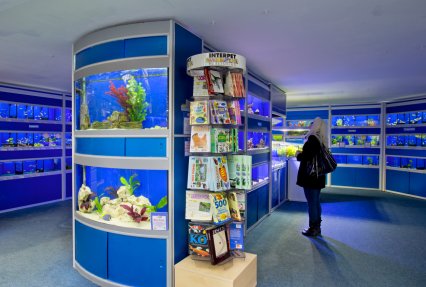When shopping for fish, do you ever pay attention to whether the retailer's tanks are run on a central filtration system or with separate filters and heaters in each tank? Do you have a preference — and do you think it makes any difference to the fish you buy? Jeremy Gay wants to hear your views.
On a recent PFK shoptour feature we visited four shops in one day, and I noted that of the four, two were using linked up tanks with sumps and large centralised filtration and heating, and two were using individually filtered and heated tanks.
The centralised and individually filtered tanks differed too. One centrally filtered fish room was fitted out by a popular and well known company, providing smart looking tropical, coldwater, marine fish, coral and plant solutions, while another chose to build their centralised systems in house.
Of the individually filtered tanks, one went for traditional undergravel filters while another opted for their own in-house design using foam and biological filter media built into the corner of the tanks.
All had healthy, saleable fish on the day and satisfied customers, but what I want to know is if you notice a difference or have a preference for one type of shops sales tank over another? Here's a brief overview of what each type entails:

Systems
This is when two or more tanks are drilled and linked up to a sump tank and filter below. In most shops you'll typically see tiered systems, perhaps three tiers high, either in modular racking holding say three tiers of two foot long tanks, by two tanks wide.
Several of these racks will make up the display along a wall or in a fish room, or the retailer may have decided to build one or more large systems with sumps and one mega filter joining up say 48 tanks or more at a time.
The sumps may be underneath the systems, behind them or in another room.
Advantages with a tank system include stability of water quality and temperature by creating a large volume of water. When lots of tanks are linked up you may only need one very large heater (connected to the sump,) and one very large pump to distribute water to all the tanks above.
This can save money in terms of set up costs and running costs, and you'll only have one pump and heater to maintain. Most if not every system employ Ultra Violet Sterilisers on the pump outlet to zap disease pathogens before they get a chance to spread to the tanks, and the fish above.
All the tanks will drain into one sump, making water changes much easier. Instead of water changing six, 12 or 48 tanks individually and then going round with hose pipes or buckets and topping up them all up you can just water change the sump, meaning that the whole system gets water changed.
On the better systems I've worked on you can pump water change water off down the drain via a waste pipe very quickly and easily, and then via a ball cock and either treated tap water or RO water, top up the sump automatically with no extra work for you. You don't even get your hands wet.
Employ that technology at home in your fish house and a multiple tank water change could go like this: Open beer, flick filter to waste, drink beer, flick filter back to normal operation, drink more beer, ball cock fills up sump tank for you and water change is done. No back ache, no hoses to trip over, no buckets, and no spills. Plenty of empty beer cans though.

Individually filtered tanks
Think of a "traditional" aquatic shop and hundreds of individually filtered tanks is probably what you are picturing. Again they will be stacked on racking and multiple tiered only this time each tank has its own heat source and life support system in the form of its own filter.
Typically the filter will be air powered like an undergravel filter or an air powered sponge filter, although internal power filters or even external power filters could be used.
Advantages include keeping batches of fish physically separate (ideally with separate catching nets,) so one tank could suffer a catastrophic disease outbreak while the ones next to it are completely unaffected.
You could also have very exacting conditions in many different tanks, and for many different species, so you could have one at 24°C with pH 6.5, one at 28°C with pH 6.5, one with salt, one with medication, one blackwater, one brackish, one planted etc etc.
Systems can also do this only most shops wouldn't have more than four different environments running within those systems. With individually filtered tanks you could have 100 tanks with 100 different conditions. In theory anyway.
So let me know by leaving a comment below. Do you consciously prefer fish from one type of shop sales tank over another, do you notice a difference in the fish you buy once you get them home, or happily buy from both?
What does it for you? Slick modern fixtures and fittings, that nostalgic bubbling sound from a hundred undergravels?







